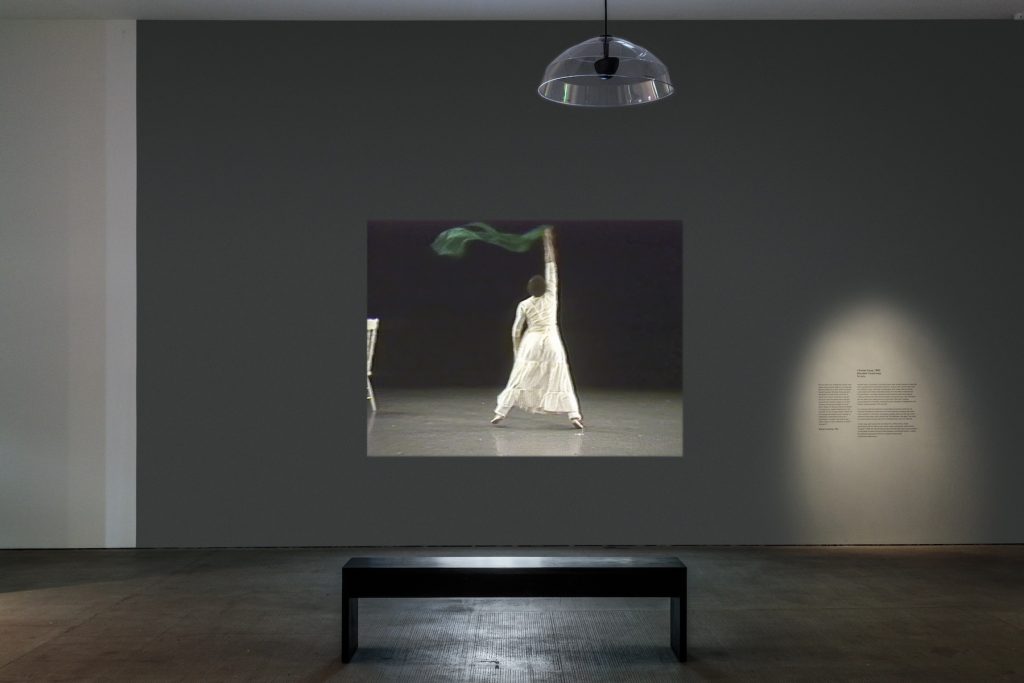Blondell Cummings (1944-2015), an American modern dancer known for her experimental choreography, was a prominent figure in the New York and Harlem dance worlds for several decades.
Born in South Carolina, where her parents picked cotton, she was raised in New York City. With a BA in dance and education from New York University and a master’s from Lehman College, she was an original member of the avant-garde dance company “The House,” founded in 1968 by Meredith Monk. She went on to teach at several prestigious NYC-area universities and establish her own ensemble.
In 1978, she founded the Cycle Arts Foundation, a discussion/performance workshop. Her goal, she said, was to “create a new ritual of empowerment to uplift the family.”
“Blondell Cummings: Dance as Moving Pictures,” a collaboration between Art + Practice and the Getty Research Institute’s African American Art History Initiative, opened September 18 at A + P’s exhibition space and runs through February 19, 2022.
This marks the first museum exhibition and book dedicated to the artist.
Certain kinds of modern dance feature jerky, violent movements so desperate to be “original” and “subversive” that they become utterly divorced from human emotion or experience.
Blondell Cummings does the opposite. Jubilant, earthy, celebratory, mischievous, she invites us to see the dance “inside” our most homely tasks, chores, and daily activities. Layered through her soundtracks are oral histories; whispered, overheard and remembered conversations through open windows or over the kitchen table. Throughout her career, she collaborated with avant-garde musicians and writers.
She is best known for “Chicken Soup” (1981), a dance inspired by her childhood memories of watching her grandmother at work. This is no twee waltz with a frying pan, however; no snappy number using a dish towel as prop.
Though video of Cummings’ performances is rare, on Vimeo you can watch a two-minute excerpt of “Chicken Soup,” filmed at Jacob’s Pillow in 1989.
The music (by Meredith Monk, Brian Eno and Collin Walcott) consists of a simple haunting tune picked out one note at a time on a piano, along with poetry by Grace Paley and Pat Stein. In a long sleeveless pink dress and leg warmers, Cummings sits in a chair and drinks iced coffee, chats with the neighbors, rocks. The quality of the film and sound are terrible.
Even so, the performance is galvanizing: Cummings’ movements are kinetically energetic but never histrionic; bursting from an inner wellspring that insists on hope and perseverance in the face of suffering. She’s up to something fresh and new, and you’re spellbound trying to figure out what.
All the more reason to visit A + P’s exhibit, much of which is drawn from Cummings’ personal video archive, and view the dance in its entirety, along with others from her “Food for Thought” suite, including “Tossed Salad” and “With House Dressing.”
Also on view are photographs, interviews, and such lesser-known dance films as “Cycle” (1978) and “In Night Stir” (1983).
The exhibit is open Wednesday-Saturday, 12-6 p.m. Free admission and no advance reservations are required.
An accompanying Getty Research Institute Resource Guide includes a selection of archives, additional primary sources, and secondary sources that demonstrate the reach and range of Cummings’ work.
The French philosopher Simone Weil once observed: “Absolute attention is prayer.” Cummings’ attention is focused on the human body in its most humble, workaday form: simultaneously a utilitarian tool and an object of reverence and wonder.
She’s both attentive to the task at hand and utterly absorbed within herself. Far from resenting work that’s “beneath her,” she gives herself to it physically, mentally, emotionally, and spiritually. The joy isn’t separate from but inherent in the effort to leave the floors spotless, the counter shining, the towels neatly hung.
From a 1983 New York Times review: “Small, sturdy, and wholehearted, she moves with the directness of an old friend settling down for a heart-to-heart talk. There is not a trace of rhetoric in her gestures, nor the irony with which so many performance artists play it safe today. Yet to see her seize the scrub brush, for instance, is to know about work and energy and living long.”
Glenn Phillips, senior curator and head of exhibitions at the Getty Research Institute (GRI), observes: “You don’t have to have dance training to appreciate her work. You can see what the movements are rooted in. You can understand what she’s communicating because she communicates it so well. And so many of her themes are around things like food, family, aging, major life moments. Her work really speaks to people of all ages.”
To whet your appetite, you can check out a YouTube video called “Blondell Cummings — A Commitment: Two Portraits.”
The first is an excerpt from her “Food for Thought” series.
The second, entitled “Nun,” features Cummings in a religious habit, the sole surviving teacher at a tropical mission school that’s been targeted by brutal violence. “All the young men have disappeared into the mountains, you see, and I teach reading and writing as if they were the most important things in the world.”
“Why am I still here? What am I hanging onto? Because everything is important. Nothing is wasted and everything is important.”

